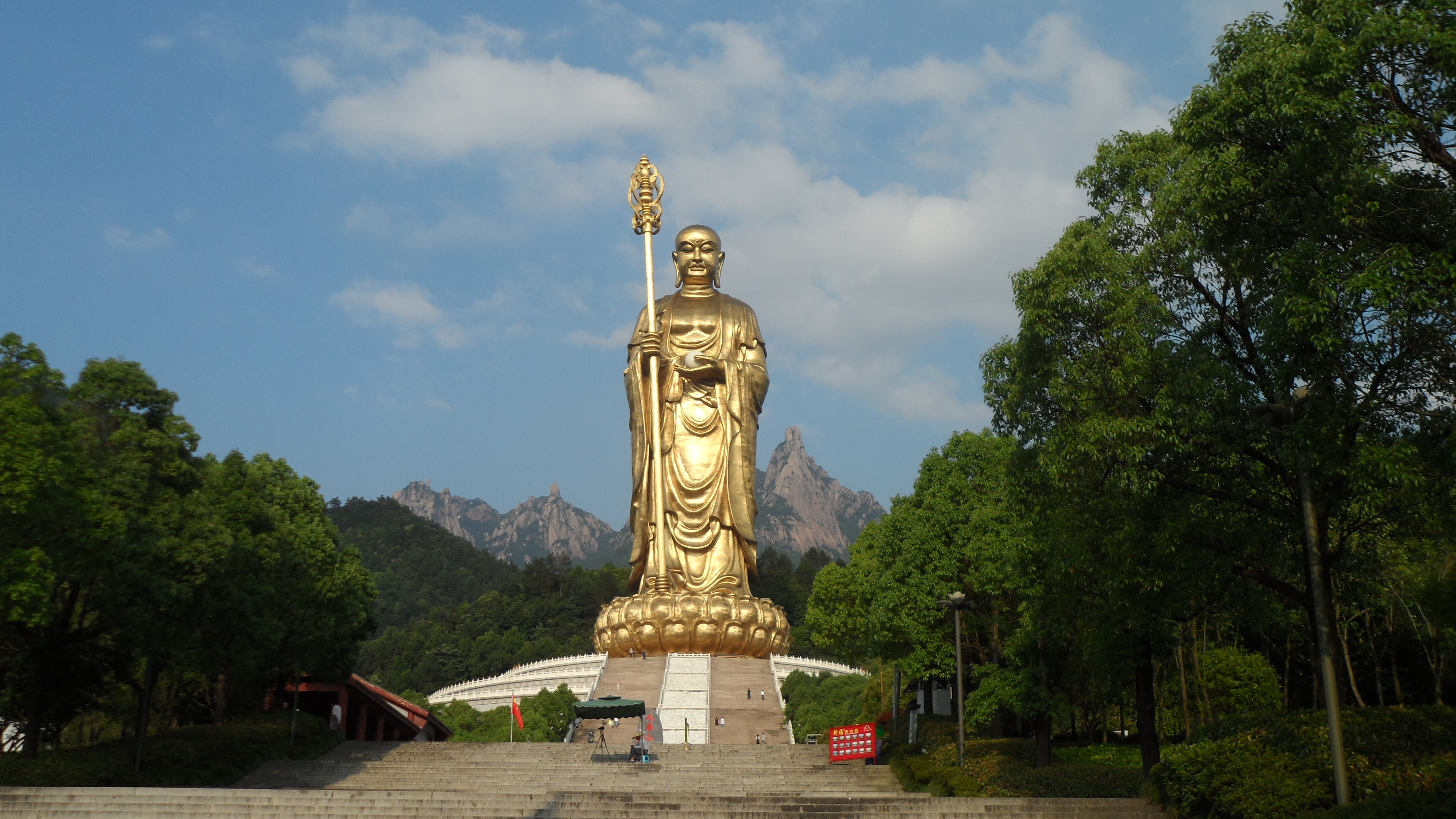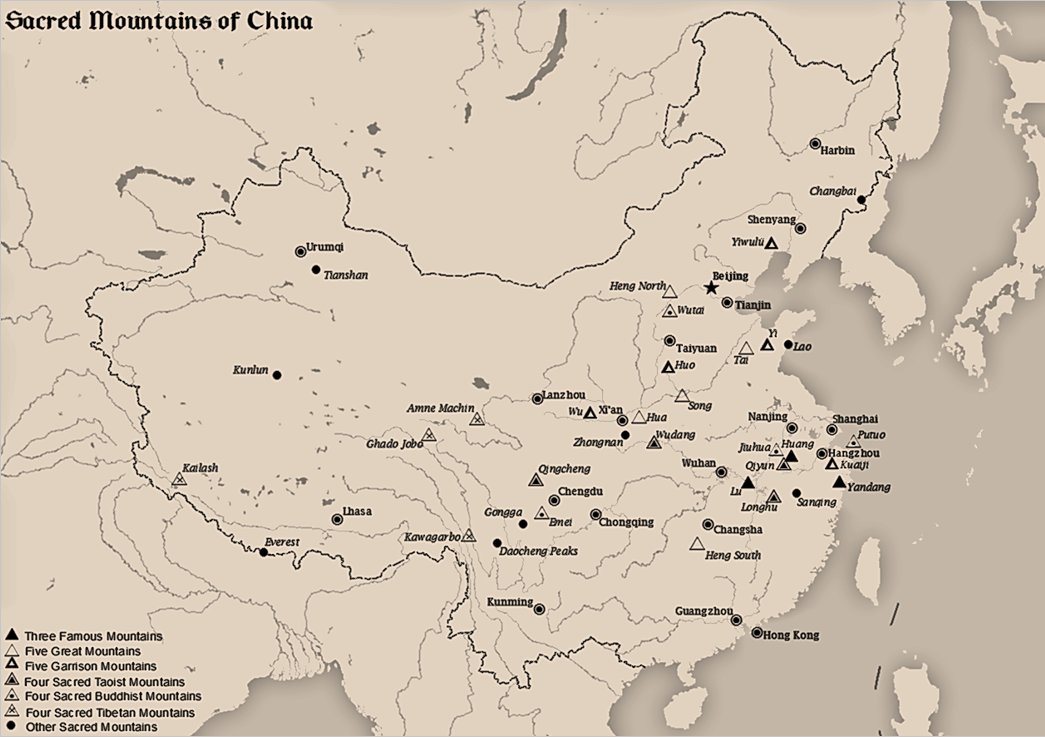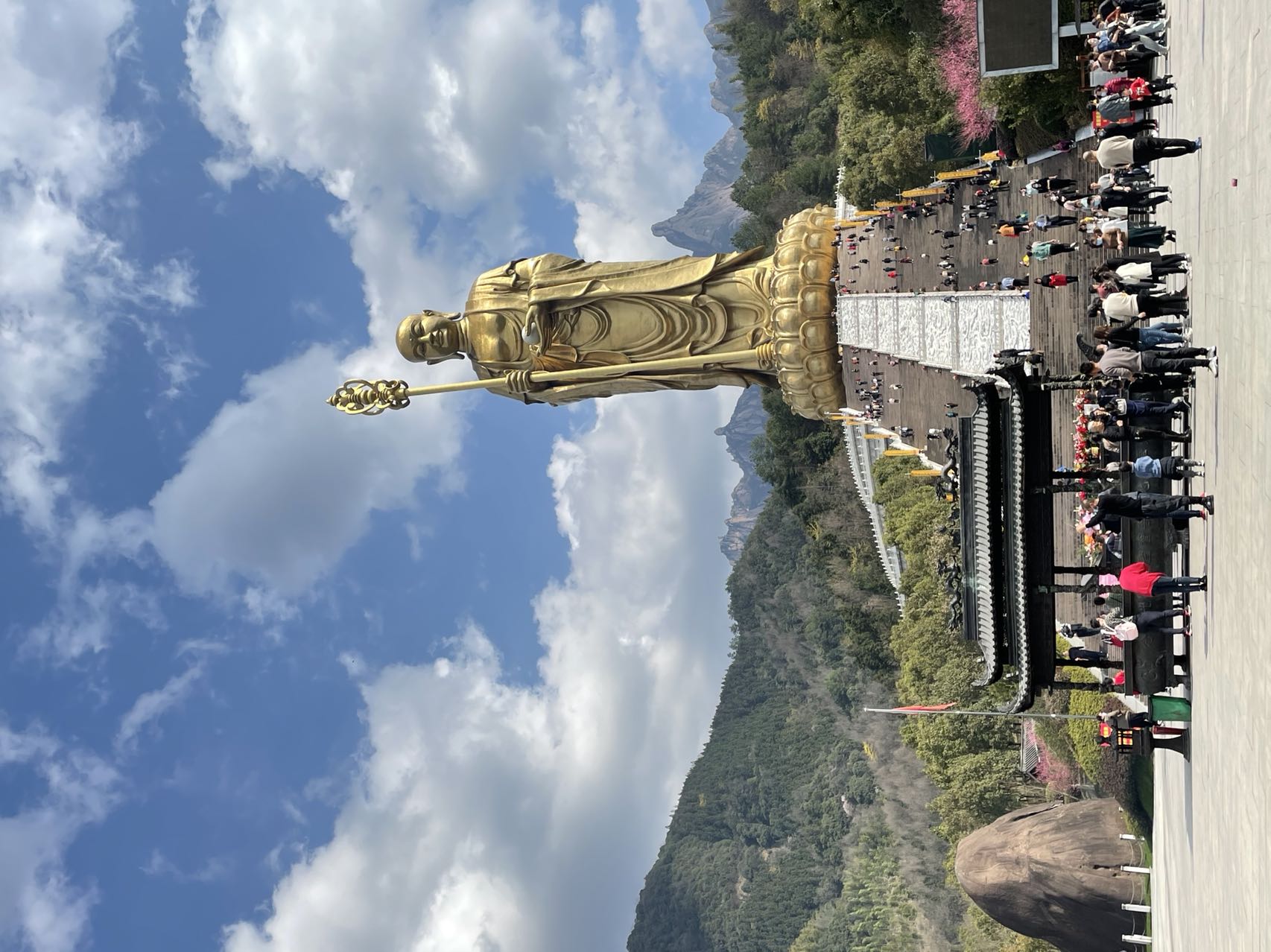|
Dizang Of Mount Jiuhua
The Dizang of Mount Jiuhua is a high ( including pedestal, and including staff) statue of a standing bodhisattva Kṣitigarbha located in Qingyang County, Chizhou, Anhui Province, China on Mount Jiuhua. It is located in the Huashan Dayuan Cultural Park. As of 2025, it is the fifteenth-tallest statue in the world. History The statue's construction was completed in 2012. Design The statue is located in one of the four sacred Buddhist mountains in China, Mount Jiuhua, and is made of bronze painted gold. It stands on a lotus throne and holds a ''khakkhara A khakkhara (; ; ; ), sometimes referred to in English as a pewter staff, is a staff topped with metal rings traditionally carried by Buddhism, Buddhist monks, particularly in East Asian Buddhism. Originally used as a noisemaker to announce a m ...'' pewter staff in the right hand and a ''cintāmaṇi'' pearl in the left hand. It stands on a high pedestal.{{Cite web , title=Mount Jiuhua (Jiuhuashan): Buddhist Mount ... [...More Info...] [...Related Items...] OR: [Wikipedia] [Google] [Baidu] |
Mount Jiuhua
Mount Jiuhua () located in Chizhou, Anhui Province in China is an important Buddhist site and natural scenic spot. It is one of the four famous Buddhist mountains in China, one of the first batch of 5A level scenic spots in China, one of the first batch of natural and cultural heritage sites in China, and the main scenic spot of "two mountains and one lake" (Jiuhua Mountain, Taiping Lake, Huangshan) tourism development strategy in Anhui Province. The planned area of the scenic spot is 120 square kilometers, and the protected area is 174 square kilometers, which is composed of 11 scenic spots. History Mount Jiuhua was called Mount Lingyang during the time of the Han dynasty. It was called Mount Jiuzi (九子山) during the Liang and Chen dynasties of the South Dynasties period. A legend says that the great poet Li Bai of the Tang dynasty travelled here and wrote "Magic is divided to two branches, sacred mountain generates nine glories." (), giving rise to its name Mount Jiuh ... [...More Info...] [...Related Items...] OR: [Wikipedia] [Google] [Baidu] |
List Of Tallest Statues
This list of tallest statues includes completed statues that are at least tall. The height values in this list are measured to the highest part of the human (or animal) figure, but exclude the height of any pedestal (plinth), or other base platform as well as any mast, spire, or other structure that extends higher than the tallest figure in the monument. The definition of for this list is a free-standing sculpture (as opposed to a relief), representing one or more people or animals (real or mythical), in their entirety or partially (such as a Bust (sculpture), bust). Heights stated are those of the statue itself and (separately) the total height of the monument that includes structures the statue is standing on or holding. Monuments that contain statues are included in this list only if the statue fulfills these and the height criteria. Existing By country/region Destroyed Proposed or under construction See also * List of statues * List of tallest bridges * ... [...More Info...] [...Related Items...] OR: [Wikipedia] [Google] [Baidu] |
Outdoor Sculptures In China
Outdoor(s) may refer to: *Wilderness *Natural environment *Outdoor cooking *Outdoor education *Outdoor equipment *Outdoor fitness *Outdoor literature *Outdoor recreation *Outdoor Channel, an American pay television channel focused on the outdoors * See also * * * ''Out of Doors'' (Bartók) *Field (other) *Outside (other) Outside or Outsides may refer to: * Wilderness Books and magazines * ''Outside'', a book by Marguerite Duras * ''Outside'' (magazine), an outdoors magazine Film, theatre and TV * Outside TV (formerly RSN Television), a television network * ' ... *'' The Great Outdoors (other)'' {{disambiguation ... [...More Info...] [...Related Items...] OR: [Wikipedia] [Google] [Baidu] |
Colossal Statues In China
Colossal may refer to: * Colossal statue, generally taken to mean a statue at least twice life-size * ''Colossal'' (film), a 2016 science fiction film starring Anne Hathaway * (Colossal) Pictures, entertainment company which closed in 2000 * Colossal (band), American punk band formed in 2001 * "Colossal", a song by Scale the Summit from the album '' The Collective'' * "Colossal", a song by Wolfmother from their debut album ''Wolfmother'' * Colossal (blog), art and visual culture blog * Colossal (chestnut), American chestnut cultivar * Colossal Biosciences, a biotechnology company See also * * * Colossal Connection, former professional wrestling tag team * Colossal Kongs, former professional wrestling tag team * Colossus (other) Colossus, Colossos, or the plural Colossi or Colossuses, may refer to: Statues * Any exceptionally large statue; colossal statues, are generally taken to mean a statue at least twice life-size ** List of tallest statues ** :Colossal statu ... [...More Info...] [...Related Items...] OR: [Wikipedia] [Google] [Baidu] |
Huangshan
Huangshan ( zh, s=黄山),Bernstein, pp. 125–127. literally meaning the Yellow Mountain(s), is a mountain range in southern Anhui province in eastern China. It was originally called "Yishan", and it was renamed because of a legend that Emperor Xuanyuan once made alchemy here. Vegetation on the range is thickest below , with trees growing up to the treeline at . The area is well known for its scenery, sunsets, peculiarly-shaped granite peaks, Huangshan pine trees, hot springs, winter snow and views of the clouds from above. Huangshan is a frequent subject of traditional Chinese paintings and literature, as well as modern photography. It is a UNESCO World Heritage Site and one of China's major tourist destinations. Physical description The Huangshan mountain range has many peaks, some more than 1,000 meters (3,250 feet) high. The three tallest and best-known peaks are ''Lotus Peak'' (Lianhua Feng, 1,864 m), ''Bright Peak'' (Guangming Ding, 1,860 m) and ''Celestial Pe ... [...More Info...] [...Related Items...] OR: [Wikipedia] [Google] [Baidu] |
Cintamani
Cintāmaṇi (Sanskrit; Devanagari: ; zh, c=如意寶珠, p=Rúyì bǎozhū; ; Korean: 여의보주/yeouiboju; Japanese Romaji: ), also spelled as Chintamani (or the ''Chintamani Stone''), is a wish-fulfilling jewel resembling a pearl described in Hindu and Mahayana Buddhist traditions. It is one of several Mani Jewel images found in Buddhist scripture. Within Hinduism, it is connected with the gods Vishnu and Ganesha. In Hindu tradition, it is often depicted as a fabulous jewel in the possession of Vishnu as the Kaustubha Mani or as on the forehead of the Naga king called as Naga Mani, or on the forehead of the Makara. The ''Yoga Vasistha'', originally written in the 10th century CE, contains a story about the cintamani. The Hindu Vishnu Purana speaks of the " Syamanta jewel, bestowing prosperity upon its owner, encapsulates the Yadu clan system". The Vishnu Purana is attributed to the mid-first millennium CE. In Buddhism, it is held by the Bodhisattvas (divine beings with ... [...More Info...] [...Related Items...] OR: [Wikipedia] [Google] [Baidu] |
Khakkhara
A khakkhara (; ; ; ), sometimes referred to in English as a pewter staff, is a staff topped with metal rings traditionally carried by Buddhism, Buddhist monks, particularly in East Asian Buddhism. Originally used as a noisemaker to announce a monk's presence and frighten away animals, it was adapted for use as a rhythmic instrument during chanting and sutra recitation, and for use as a weapon.music dictionary : Sf - Si at www.dolmetsch.com It is also known as a "tiger pewter staff" ( zh, c=虎錫, p=Hǔ xī), due to its traditional use of driving away predatory animals. The earliest recorded description of a khakkhara is in the writings of the Chinese pilgrim monk Yijing (monk), Yijing who traveled between China, Indonesia, and India in the years 671 to 695 AD. Design The basic design of a khakkhara is of a cen ...[...More Info...] [...Related Items...] OR: [Wikipedia] [Google] [Baidu] |
Lotus Throne
The lotus throne, sometimes called lotus platform, is a stylized lotus flower used as the seat or base for a figure in art associated with Indian religions. It is the normal pedestal for divine figures in Buddhist art and Hindu art, and often seen in Jain art. Originating in Indian art, it followed Indian religions to East Asia in particular. The precise form varies, but is intended to represent the opening flower of ''Nelumbo nucifera'', the Indian lotus. In the traditional biographies lotus flowers sprung up at the Buddha's first seven steps, and in some Buddhist legends the baby Padmasambhava emerged from a lotus flower. The Indian lotus is an aquatic plant similar to a Nymphaeaceae, water lily, though not actually any close relation. It has a large, round, and flat Receptacle (botany), seed head in the centre of the flower, with initially small openings above each of the relatively small number of seeds. Among other unusual characteristics, ''nelumbo nucifera'' has partic ... [...More Info...] [...Related Items...] OR: [Wikipedia] [Google] [Baidu] |
Sacred Mountains Of China
The Sacred Mountains of China are divided into several groups. The ''Five Great Mountains'' () refers to five of the most renowned mountains in Chinese history, which have been the subjects of imperial pilgrimage by emperors throughout ages. They are associated with the supreme God of Heaven and the five main cosmic deities of traditional Chinese religion. The group associated with Buddhism is referred to as the ''Four Sacred Mountains of Buddhism'' (), and the group associated with Taoism is referred to as the ''Four Sacred Mountains of Taoism'' (). The sacred mountains have all been important destinations for pilgrimage, the Chinese term for pilgrimage () being a shortened version of an expression which means "paying respect to a holy mountain" (). The Five Great Mountains The ''Five Great Mountains'' or ''Wuyue'' are arranged according to the five cardinal directions of Chinese geomancy, which includes the center as a direction. The grouping of the five mountains appear ... [...More Info...] [...Related Items...] OR: [Wikipedia] [Google] [Baidu] |
Jiuhua Dayuan Culture Park 3
Mount Jiuhua () located in Chizhou, Anhui Province in China is an important Buddhist site and natural scenic spot. It is one of the four famous Buddhist mountains in China, one of the first batch of 5A level scenic spots in China, one of the first batch of natural and cultural heritage sites in China, and the main scenic spot of "two mountains and one lake" (Jiuhua Mountain, Taiping Lake, Huangshan) tourism development strategy in Anhui Province. The planned area of the scenic spot is 120 square kilometers, and the protected area is 174 square kilometers, which is composed of 11 scenic spots. History Mount Jiuhua was called Mount Lingyang during the time of the Han dynasty. It was called Mount Jiuzi (九子山) during the Liang and Chen dynasties of the South Dynasties period. A legend says that the great poet Li Bai of the Tang dynasty travelled here and wrote "Magic is divided to two branches, sacred mountain generates nine glories." (), giving rise to its name Mount Jiuhua. ... [...More Info...] [...Related Items...] OR: [Wikipedia] [Google] [Baidu] |
Huashan Dayuan Cultural Park
Mount Hua () is a mountain located near the city of Huayin in Shaanxi Province, about east of Xi'an. It is the "Western Mountain" of the Five Great Mountains of China and has a long history of religious significance. Originally classified as having three peaks, in modern times it is classified as having five main peaks, the highest of which is the South Peak at . Names Mount Hua is also called Huashan, its literal name, and nicknamed "Number One Steepest Mountain Under Heaven." Geography Mount Hua is located near the southeast corner of the Ordos Loop section of the Yellow River basin, south of the Wei River valley, at the eastern end of the Qin Mountains, in Southern Shaanxi Province. It is part of the Qinling or Qin Mountains, which divide not only northern and southern Shaanxi, but also China. Summits Traditionally, only the giant plateau with its summits to the south of the peak Wuyun Feng (, Five Cloud Summit) was called Taihua Shan (, Great Flower Mountain). It could ... [...More Info...] [...Related Items...] OR: [Wikipedia] [Google] [Baidu] |
Qingyang, Anhui
Qingyang County () is a county in the south of Anhui Province, People's Republic of China. It is the northeasternmost county-level division of the prefecture-level city of Chizhou Chizhou () is a prefecture-level city in the south of Anhui province, China. It borders Anqing to the northwest, Tongling and Wuhu to the northeast, Xuancheng to the east, Huangshan to the southeast, and the province of Jiangxi to the southwest .... It has a population of and an area of . The government of Qingyang County is located in Rongcheng Town. Qingyang county benefited in 1540 from Ming literate Mao Kun ()(1512–1601)'s brief (2-month) tenure as magistrate. He helped the coppersmiths of the area by shutting down illegal shops that were being run by people from outside the county, and mitigated the abuses of local bullies. The county honored him with a shrine when he had to return home to mourn his father's death according to traditional rite. Administrative divisions Qingyang Count ... [...More Info...] [...Related Items...] OR: [Wikipedia] [Google] [Baidu] |






